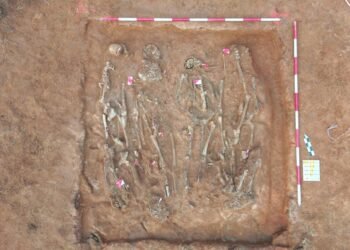A recent study reveals that the bond between humans and canines in the Americas dates back at least 12,000 years—2,000 years earlier than previously believed.

Conducted by a team led by Dr. François Lanoë, an assistant research professor at the University of Arizona’s School of Anthropology, the research draws on archaeological findings from Alaska. The study, published in Science Advances, provides compelling evidence of early interactions between Indigenous people and the ancestors of modern dogs or tamed wolves.
The research team discovered a 12,000-year-old canine tibia at Swan Point, an archaeological site about 70 miles southeast of Fairbanks. Radiocarbon dating confirmed the bone’s age, situating it near the end of the Ice Age. In June 2023, the team also uncovered an 8,100-year-old jawbone from another site, Hollembaek Hill, south of Delta Junction. Both bones displayed signs of potential domestication.
Chemical analysis revealed a surprising dietary detail: substantial traces of salmon proteins. “This is the smoking gun because they’re not really going after salmon in the wild,” explained Ben Potter, an archaeologist at the University of Alaska Fairbanks and co-author of the study. The consistent presence of salmon in the diet of these canines strongly suggests reliance on humans for food, a behavior indicative of domestication or close association.

Despite these findings, the genetic analysis indicates that these ancient canines are not directly related to modern dog populations. Dr. Lanoë noted, “Behaviorally, they seem to be like dogs, as they ate salmon provided by people, but genetically, they’re not related to anything we know.” This raises the possibility that these animals were tamed wolves rather than fully domesticated dogs.
The study also highlights the essential role of Indigenous partnerships. Archaeological work in Alaska’s Tanana Valley has been ongoing since the 1930s, with researchers regularly consulting the Healy Lake Village Council, which represents the Mendas Cha’ag people. The council approved the genetic testing of the canine specimens for this study.
Evelynn Combs, a Healy Lake member and archaeologist, said: “It is little—but it is profound—to get the proper permission and to respect those who live on that land.” Combs, who grew up exploring archaeological sites in the Tanana Valley, described the enduring bond between humans and dogs in her community, noting that nearly every resident in her village has a close relationship with a dog.
Dr. Lanoë emphasized the broader implications of the discoveries: “Until you find those animals in archaeological sites, we can speculate about it, but it’s hard to prove one way or another. So, this is a significant contribution.”























